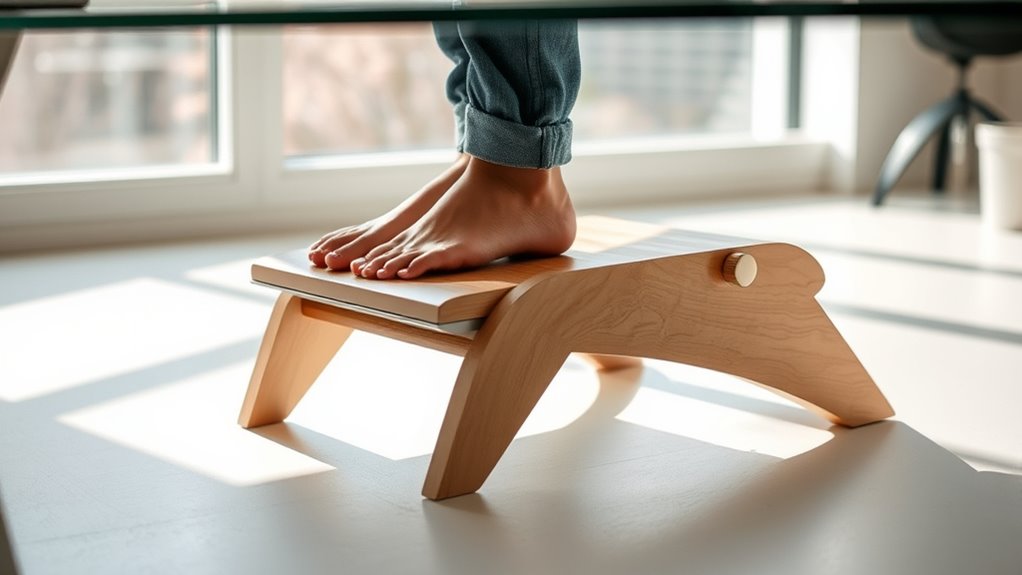To choose the perfect footrest height, start by ensuring your knees are comfortably bent at about 90°, with your feet flat on the rest or floor. Adjust the height so your heels, arches, and toes all stay supported without dangling or slipping. Consider your desk and chair setup to maintain proper posture, and opt for an adjustable footrest for personalized comfort. Keep in mind your footwear and workspace, and regular fine-tuning helps stay ergonomic over time—discover more tips ahead.
Key Takeaways
- Measure the distance from your heel to the bottom of your thigh to determine the ideal footrest height.
- Ensure your knees are comfortably bent at around 90° when seated with feet on the footrest.
- Choose a footrest that supports your entire foot flat, preventing dangling or slumping.
- Adjust the height so your feet are supported without causing strain or discomfort in your ankles or legs.
- Consider your workspace setup, including desk height and footwear, to select a footrest that promotes proper posture.
Understanding the Importance of Proper Footrest Height
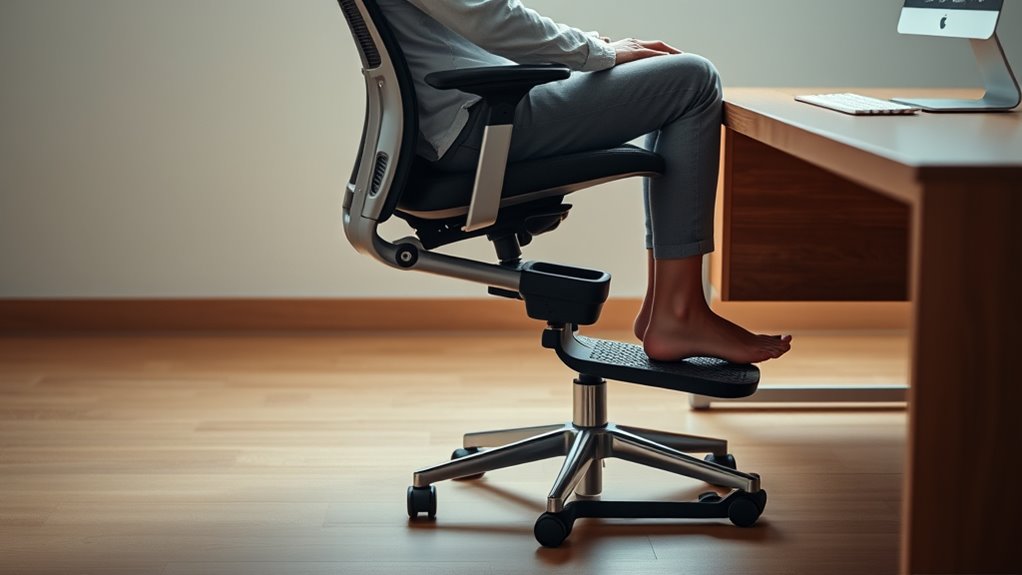
Proper footrest height is essential for maintaining good posture and preventing discomfort during prolonged sitting. When your footrest is at the right height, it provides ideal ankle support, reducing strain and promoting circulation. If it’s too high or low, you might feel tension in your ankles and legs, leading to fatigue. The materials of your footrest also matter; sturdy, non-slip surfaces like wood, foam, or rubber offer stability and comfort. Comfortable footrest materials help keep your feet supported without slipping, ensuring your posture remains aligned. By choosing a footrest with the appropriate height and quality materials, you create a stable base that encourages proper ergonomic positioning, minimizing aches and long-term issues associated with poor seating habits. Additionally, understanding how footrest height influences overall comfort can help you make better ergonomic choices.
Measuring Your Ideal Sitting Position
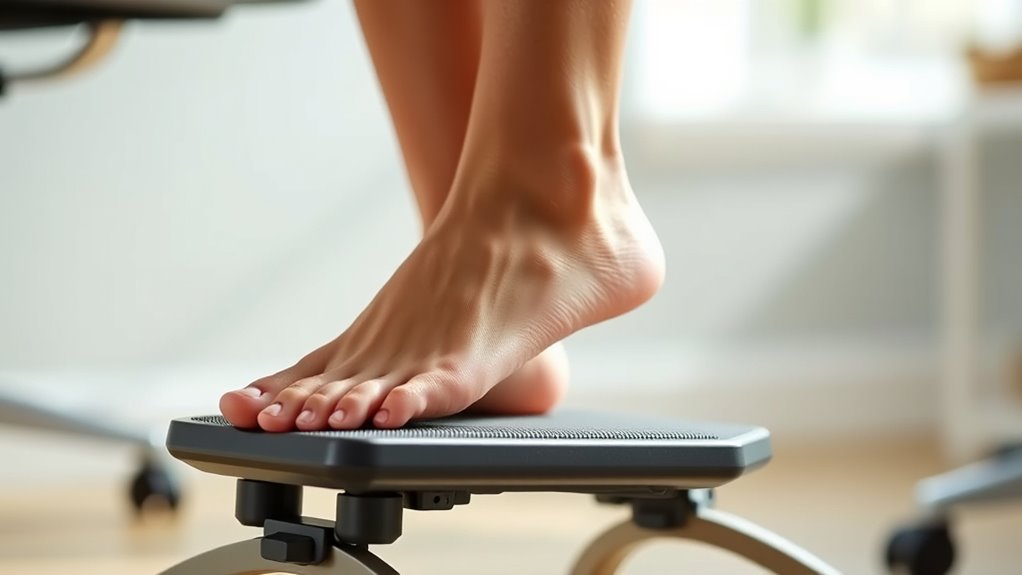
Start by checking your leg position to make certain your knees are comfortably bent at about a 90-degree angle. Use a measuring tool to find the right height, aiming for your feet to rest flat on the floor or footrest. This way, you’ll find a sitting position that supports good posture and comfort. Additionally, ensuring your work environment is ergonomically optimized can further enhance comfort and reduce strain during prolonged sitting.
Check Your Leg Position
To find the right footrest height, you need to check your leg position while sitting. Make sure your ankles are aligned comfortably with your knees, maintaining a natural foot posture. Your feet should rest flat on the footrest, with your knees at roughly a 90-degree angle. If your ankles are strained or your feet dangle, the footrest is too high or low. Proper support can help prevent discomfort and improve overall ergonomics, especially since home security systems have become increasingly important for safety. Use this table to evaluate your position:
| Footrest Height | Ankle Alignment | Foot Posture |
|---|---|---|
| Too high | Dorsiflexed | Tension in calves |
| Too low | Plantarflexed | Foot slumped or curled |
| Just right | Neutral | Feet flat, relaxed |
Check your leg position regularly to ensure comfort and proper support.
Use a Measuring Tool
Using a measuring tool can help you determine the ideal footrest height for your body. Start by measuring the distance from your heel to the bottom of your thigh while seated in your usual position. This measurement guides you in selecting a footrest that supports your feet comfortably. When choosing a footrest, consider the materials—whether padded, wooden, or adjustable—to match your comfort needs and aesthetic design preferences. A sturdy, well-made footrest ensures stability, while the right height promotes proper posture. Using accurate measurements prevents guesswork and guarantees the footrest fits seamlessly into your workspace or living area. Additionally, understanding narcissistic traits can help you select a footrest that not only supports your posture but also aligns with your personal needs for comfort and style. Ultimately, measuring carefully helps you find a footrest that balances function and style, making your sitting experience more comfortable and ergonomic.
Aim for Feet Flat
Achieving proper footrest height involves ensuring your feet rest flat on the surface, which helps maintain good posture and reduces strain. To do this, consider your shoe size and footwear support, as these affect how your feet sit comfortably. If your shoes are too tight or lack support, your feet may not lie flat naturally. Use a simple test: sit with your feet supported, and check if your heels, arches, and toes are in contact with the footrest. Adjust the height until your feet feel supported without dangling or slipping. Here’s a quick guide:
| Shoe Size | Footwear Support | Ideal Footrest Height |
|---|---|---|
| Small | Firm | Slightly lower |
| Medium | Moderate | Mid-level |
| Large | Cushioned | Slightly higher |
Find the right balance for comfort and support.
Considering Your Desk and Chair Setup
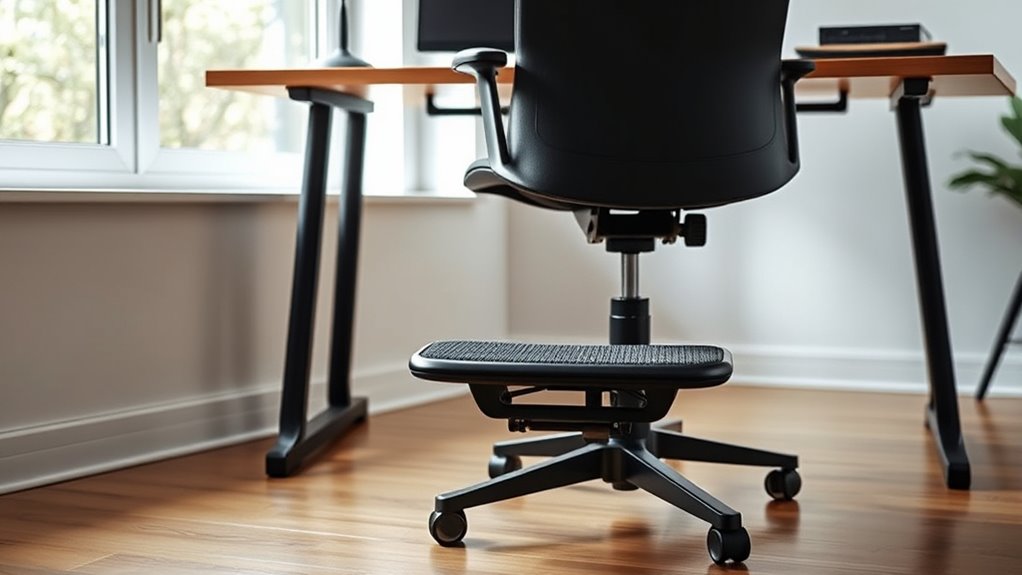
Your desk and chair setup play a crucial role in determining the ideal footrest height. The height of your desk influences how high your footrest should be, ensuring your feet rest comfortably without strain. When choosing a footrest, consider the vertical storage solutions to match your workspace’s durability and comfort needs. For example, a cushioned surface offers extra support, while a sleek, hard material might complement a modern aesthetic. Aesthetic compatibility is also important; a footrest that blends seamlessly with your desk and chair creates a cohesive look. Make sure your setup allows your knees to stay at a comfortable angle and your feet to rest flat. Balancing functionality with style helps you select a footrest that enhances both comfort and the overall workspace appearance.
Evaluating Adjustable vs. Fixed Footrests

When choosing between adjustable and fixed footrests, it’s important to contemplate how each option supports your comfort and flexibility throughout the workday. Adjustable footrests offer versatility, allowing you to customize height and angle for ideal ergonomic support, making them perfect if you frequently change sitting positions. They’re popular ergonomic accessories, helping reduce strain and improve posture. Fixed footrests, on the other hand, are simpler and more affordable, providing stable support without adjustments. While they may lack flexibility, they often blend seamlessly with your workspace’s aesthetic choices. Your decision depends on whether you prioritize adaptability or simplicity. If you value ongoing comfort and ergonomic customization, an adjustable footrest is usually the better investment. However, if aesthetics and minimalism matter most, a well-designed fixed footrest might suffice. Additionally, awareness of regional resources can be helpful if you’re seeking expert advice or specialized options in your area.
Tips for Testing and Fine-Tuning Your Footrest
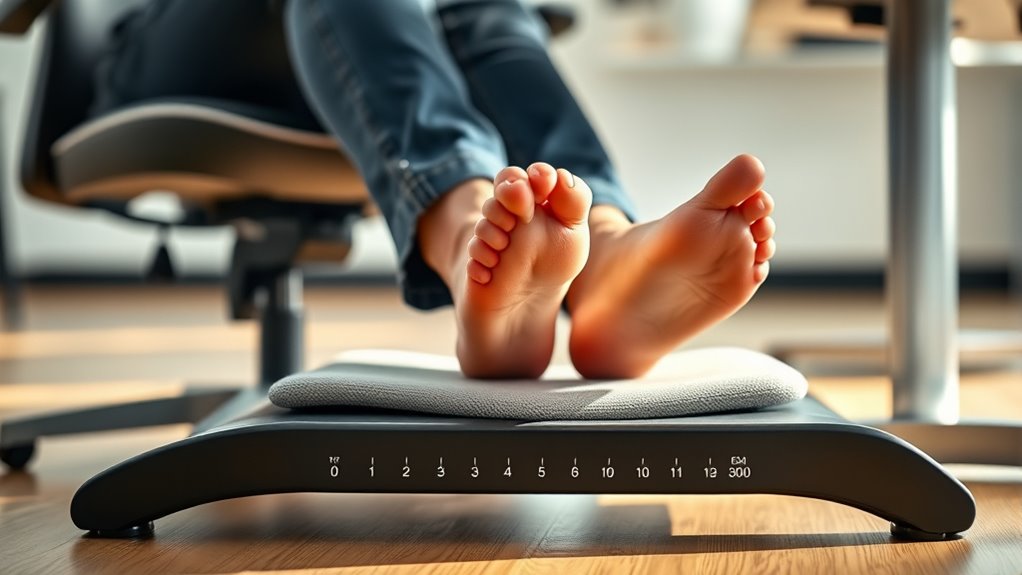
To guarantee your footrest provides ideal comfort and support, it’s vital to test and fine-tune its height and angle properly. Start by adjusting the footrest to a comfortable position, ensuring your feet are flat and knees are at a 90-degree angle. Sit for a few minutes and observe comfort levels. Consider the footrest materials—whether cushioned or firm—and how they influence support. Also, evaluate aesthetic designs that match your workspace decor. Use the table below to compare different adjustments:
| Adjustment Type | Effect on Comfort | Suitable Materials / Designs |
|---|---|---|
| Height | Reduces strain | Wooden, metal, cushioned |
| Tilt | Enhances posture | Sleek, ergonomic, minimal |
| Positioning | Improves circulation | Modern, classic styles |
| Locking Mechanism | Ensures stability | Adjustable, fixed options |
| Surface Texture | Prevents slipping | Smooth, textured surfaces |
Additionally, understanding ergonomic principles can help you select the most effective adjustments for long-term comfort. Fine-tuning these factors ensures maximum ergonomic benefits.
Maintaining Comfort and Ergonomics Over Time
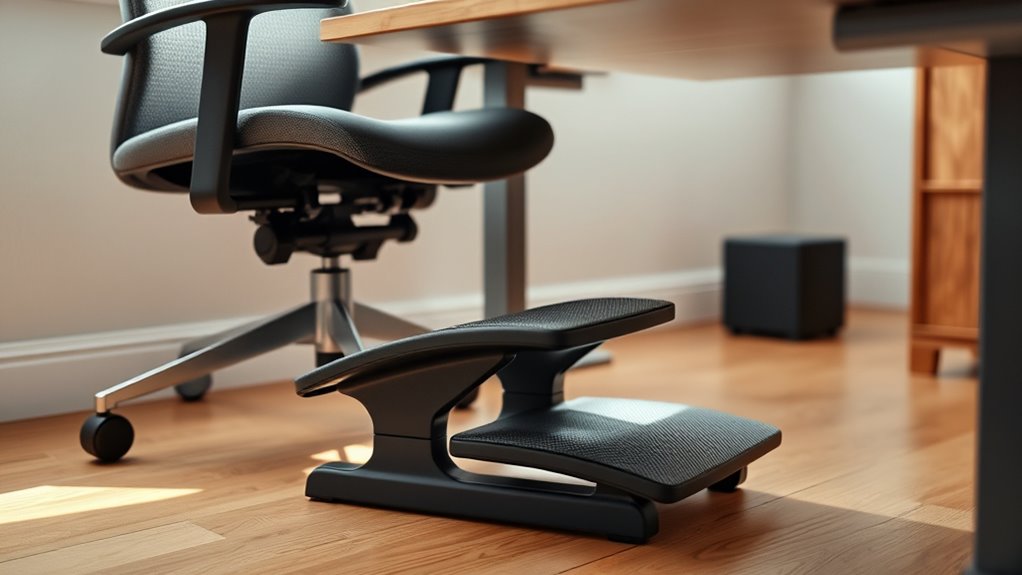
Once you’ve adjusted your footrest for ideal comfort, maintaining that ergonomic setup over time requires consistent attention. Regularly check that your footrest remains at the right height and angle, especially if you move or shift positions often. Consider the footrest materials; durable options like sturdy plastic or metal can withstand daily use, while cushioned surfaces may enhance comfort. Aesthetic considerations also matter—choose a design that complements your workspace to encourage regular use. Keep the footrest clean and inspect it periodically for signs of wear or damage. Adjustments may be needed as your posture or workspace changes. Additionally, being aware of ergonomic best practices can help ensure your setup remains effective and supportive. Staying mindful of these factors ensures your footrest continues providing proper support and comfort, reducing strain and promoting better ergonomics over time.
Frequently Asked Questions
Can a Footrest Improve Circulation During Long Work Hours?
Using a footrest can markedly boost circulation during long work hours. It provides ergonomic benefits by promoting better posture and reducing pressure on your legs and lower back. When you elevate your feet, blood flow improves, preventing numbness and swelling. You’ll feel more comfortable and alert, making it easier to focus and stay productive. So yes, a footrest actively supports circulation improvement and enhances your overall ergonomic setup.
What Materials Are Best for Durable Footrests?
When selecting a footrest, you might think softer materials are best, but durable options often provide better long-term ergonomic support. Materials like high-quality plastic, metal, or sturdy wood excel in material durability, ensuring your footrest withstands daily use. These tough materials maintain their shape and support, reducing wear and tear. Ultimately, choosing a durable material not only boosts longevity but also guarantees consistent ergonomic support for your comfort during extended sitting periods.
How Often Should I Replace My Footrest?
You should replace your footrest when it no longer provides proper support or shows significant wear. Regularly assess its condition, considering adjustment frequency and comfort. Typically, a good replacement schedule is every 1-2 years, but this depends on usage and material quality. If it becomes unstable or uncomfortable, it’s time for a new one to maintain ergonomic benefits and prevent discomfort or injury.
Are There Specific Footrests for Different Body Types?
Yes, there are specific footrests designed for different body types. You should look for footrest ergonomics that match your height and posture needs. Opt for footrest adjustability to customize the support, ensuring your feet are comfortably flat and your knees are at a 90-degree angle. This helps reduce strain and promotes proper circulation, making your workspace more comfortable and ergonomic, regardless of your body type.
Can Footrest Height Affect Overall Ergonomic Posture?
Like a compass guiding a ship, your footrest height influences your posture correction and overall comfort. If it’s too high or low, it can throw off your ergonomic alignment, causing strain. Proper footrest alignment helps maintain a natural spine curve, reducing fatigue and discomfort. Adjusting your footrest to support your feet flat and knees at a right angle ensures better posture and less tension, making your workspace more comfortable and health-friendly.
Conclusion
Choosing the perfect footrest height isn’t just a small detail—it’s your secret weapon against endless discomfort and fatigue. When you get it just right, you’ll feel like you’ve accessed the fountain of ergonomic youth, transforming your workspace into a haven of comfort. Remember, a well-chosen footrest can make your entire day feel brighter and more productive. So don’t settle—fine-tune until it feels perfect and enjoy the comfort that could rival sitting on a cloud!
